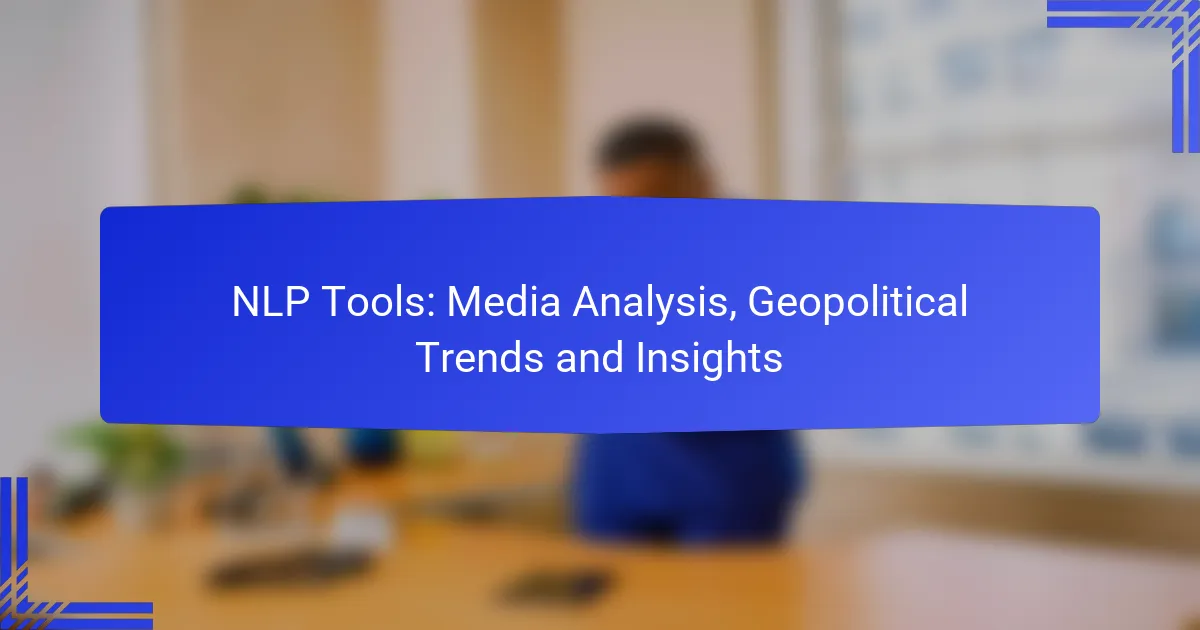NLP tools for media analysis are essential for extracting valuable insights from extensive text data, allowing organizations to identify trends, sentiments, and key topics. By leveraging advanced algorithms, these tools analyze content from diverse media sources, facilitating informed decision-making and enhancing understanding of geopolitical trends through the identification of technological advances and patterns.
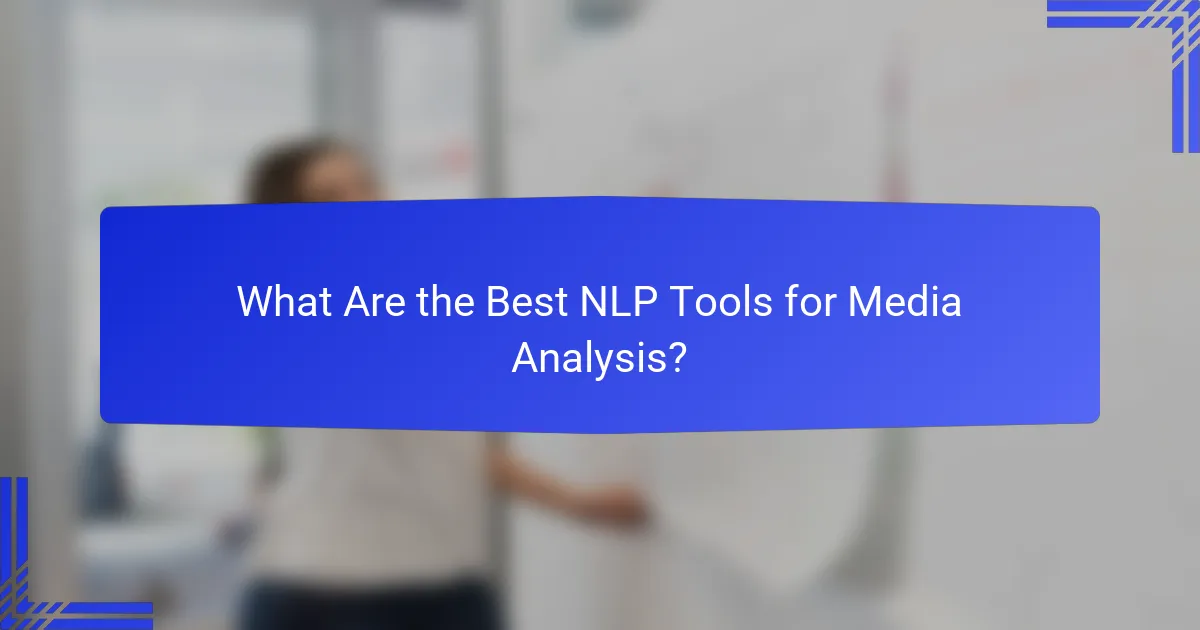
What Are the Best NLP Tools for Media Analysis?
The best NLP tools for media analysis are designed to extract insights from large volumes of text data, enabling organizations to understand trends, sentiments, and key topics. These tools leverage advanced algorithms to analyze content from various media sources, providing actionable insights for decision-making.
IBM Watson Natural Language Understanding
IBM Watson Natural Language Understanding offers powerful capabilities for analyzing text, including sentiment analysis, emotion detection, and keyword extraction. It can process data from news articles, social media, and other text sources to help organizations gauge public opinion and identify emerging trends.
When using Watson, consider its integration with other IBM services for a comprehensive analytics solution. The tool supports multiple languages and provides customizable models, making it suitable for diverse applications in media analysis.
Google Cloud Natural Language API
The Google Cloud Natural Language API provides robust features for analyzing text, such as entity recognition, sentiment analysis, and syntax analysis. It is particularly effective for processing large datasets, allowing users to derive insights from various media formats including articles, blogs, and social media posts.
This API is easy to integrate with other Google Cloud services, enhancing its functionality. Users should be aware of the pricing structure, which is based on usage, making it essential to monitor API calls to manage costs effectively.
Microsoft Azure Text Analytics
Microsoft Azure Text Analytics offers capabilities like sentiment analysis, key phrase extraction, and language detection. This tool is designed to help organizations analyze customer feedback and media content, providing insights into public sentiment and engagement.
Azure’s strength lies in its scalability and integration with other Azure services. Users should ensure they understand the pricing model, which is based on the number of text records processed, to optimize their usage and budget.
Lexalytics Semantria
Lexalytics Semantria specializes in text analytics and sentiment analysis, focusing on social media and customer feedback. It provides features like theme extraction and sentiment scoring, which are crucial for understanding public perception in media analysis.
One of Semantria’s advantages is its ability to handle unstructured data from various sources. Users should consider its customization options to tailor the analysis to specific industry needs, ensuring relevant insights are generated.
MeaningCloud
MeaningCloud offers a suite of text analytics tools, including sentiment analysis, topic extraction, and classification. It is designed for businesses looking to analyze media content and customer interactions to derive actionable insights.
This tool supports multiple languages and allows for easy integration with existing systems. Users should take advantage of its flexible pricing plans, which cater to different volumes of text analysis, ensuring cost-effectiveness based on their specific needs.
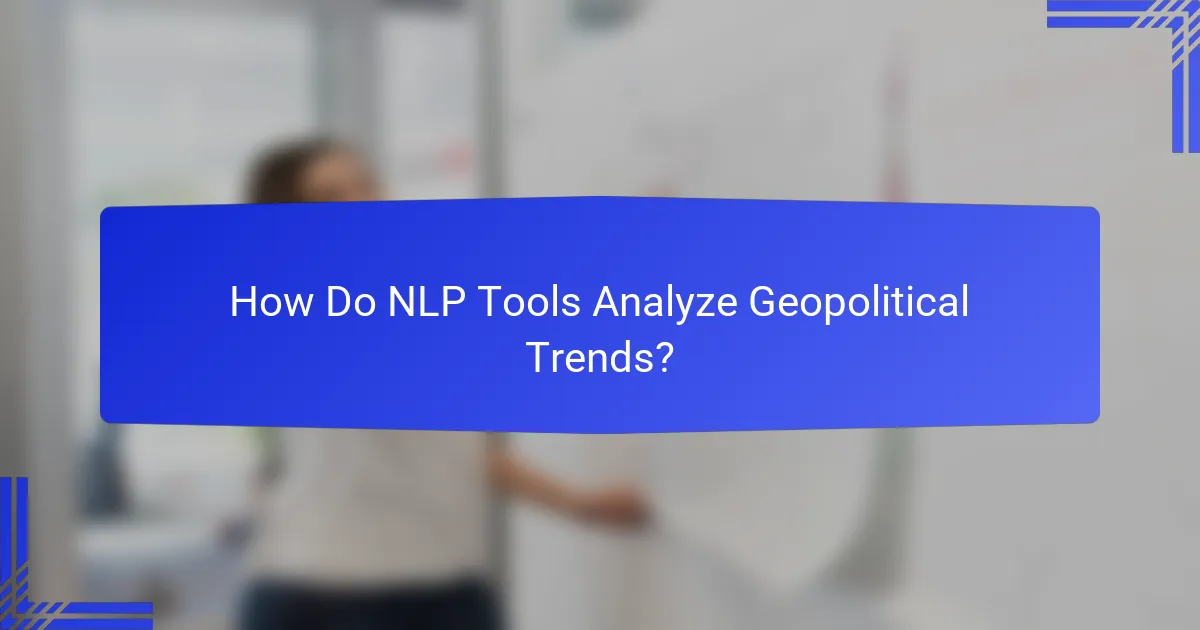
How Do NLP Tools Analyze Geopolitical Trends?
NLP tools analyze geopolitical trends by processing vast amounts of text data to identify patterns, sentiments, and emerging issues. These tools leverage machine learning algorithms to extract insights from news articles, social media posts, and other relevant sources, enabling analysts to understand public opinion and predict potential developments.
Sentiment Analysis for Political Events
Sentiment analysis involves evaluating the emotional tone behind words to gauge public opinion on political events. By analyzing social media posts, news articles, and speeches, NLP tools can categorize sentiments as positive, negative, or neutral, providing insights into how different demographics react to political changes.
For example, a spike in negative sentiment regarding a government policy may indicate rising public discontent, prompting policymakers to reconsider their strategies. It’s crucial to consider the context and source of the data, as sentiment can vary significantly across different platforms and cultures.
Trend Detection in Social Media
NLP tools can detect emerging geopolitical trends by monitoring social media platforms for specific keywords and phrases. By analyzing the frequency and context of these terms, analysts can identify shifts in public interest or concern regarding particular issues, such as international conflicts or economic policies.
For instance, a sudden increase in discussions about a specific country may signal a growing geopolitical concern. Analysts should regularly update their keyword lists and consider the influence of viral content, which can skew perceptions of trends.
Data Visualization Techniques
Data visualization techniques enhance the understanding of geopolitical trends by presenting complex data in an accessible format. Tools like graphs, heat maps, and dashboards allow analysts to visualize sentiment changes, trend patterns, and correlations over time, making it easier to communicate findings to stakeholders.
Effective visualizations should highlight key insights without overwhelming the audience. Using color coding to represent sentiment or trend intensity can improve clarity. Analysts should ensure that visualizations are updated regularly to reflect the most current data for accurate decision-making.
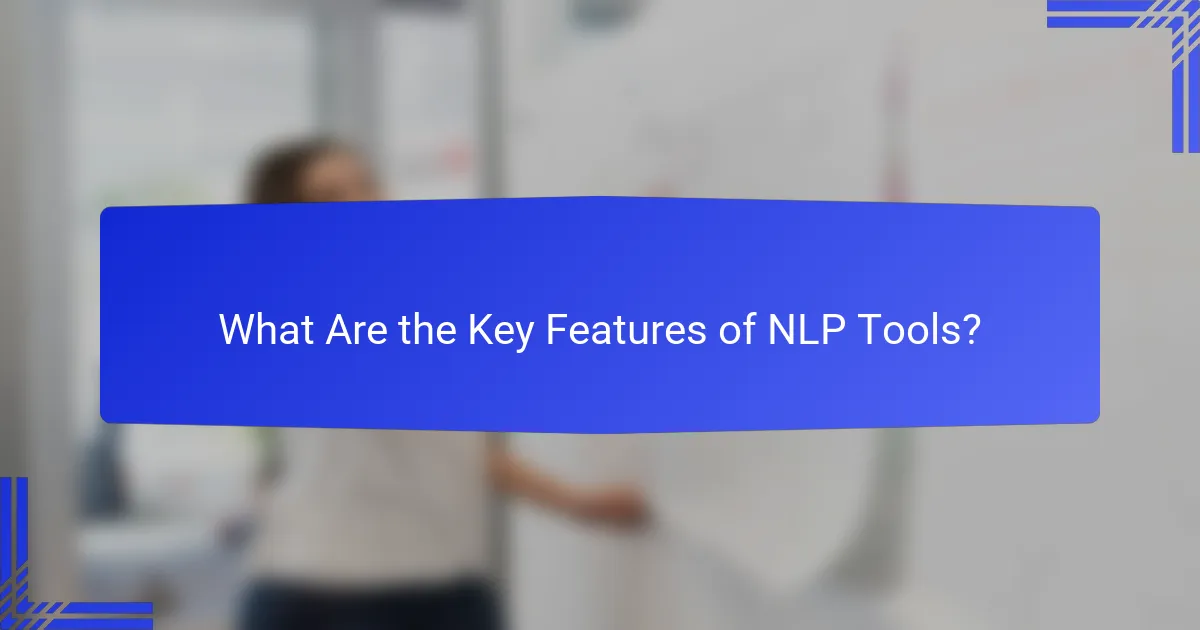
What Are the Key Features of NLP Tools?
NLP tools are designed to analyze and interpret human language, offering features that enhance media analysis and provide insights into geopolitical trends. Key functionalities include text classification, entity recognition, sentiment analysis, and language translation, each serving distinct purposes in processing and understanding textual data.
Text Classification
Text classification involves categorizing text into predefined groups based on its content. This feature is crucial for organizing large volumes of information, such as news articles or social media posts, into relevant categories like politics, sports, or entertainment.
Common approaches include supervised learning, where models are trained on labeled datasets, and unsupervised learning, which identifies patterns without prior labels. For effective classification, ensure your training data is diverse and representative of the categories you wish to define.
Entity Recognition
Entity recognition identifies and classifies key elements within text, such as names of people, organizations, locations, and dates. This feature is essential for extracting meaningful insights from unstructured data, enabling users to understand relationships and context.
Implementing entity recognition typically involves using pre-trained models or customizing them with domain-specific data. Be mindful of the nuances in language, as entities can vary significantly across different contexts and cultures.
Sentiment Analysis
Sentiment analysis evaluates the emotional tone behind a body of text, determining whether it is positive, negative, or neutral. This feature is particularly useful for gauging public opinion on topics like political events or product reviews.
To achieve accurate sentiment analysis, consider using a combination of lexicon-based approaches and machine learning models. Regularly update your models to adapt to changing language use and cultural references, which can impact sentiment interpretation.
Language Translation
Language translation tools convert text from one language to another, facilitating communication across linguistic barriers. These tools are vital for global media analysis and understanding geopolitical narratives in various languages.
When choosing a translation tool, consider the accuracy and fluency of translations, as well as the specific languages involved. Machine translation has improved significantly, but human oversight is often necessary for nuanced or culturally sensitive content.
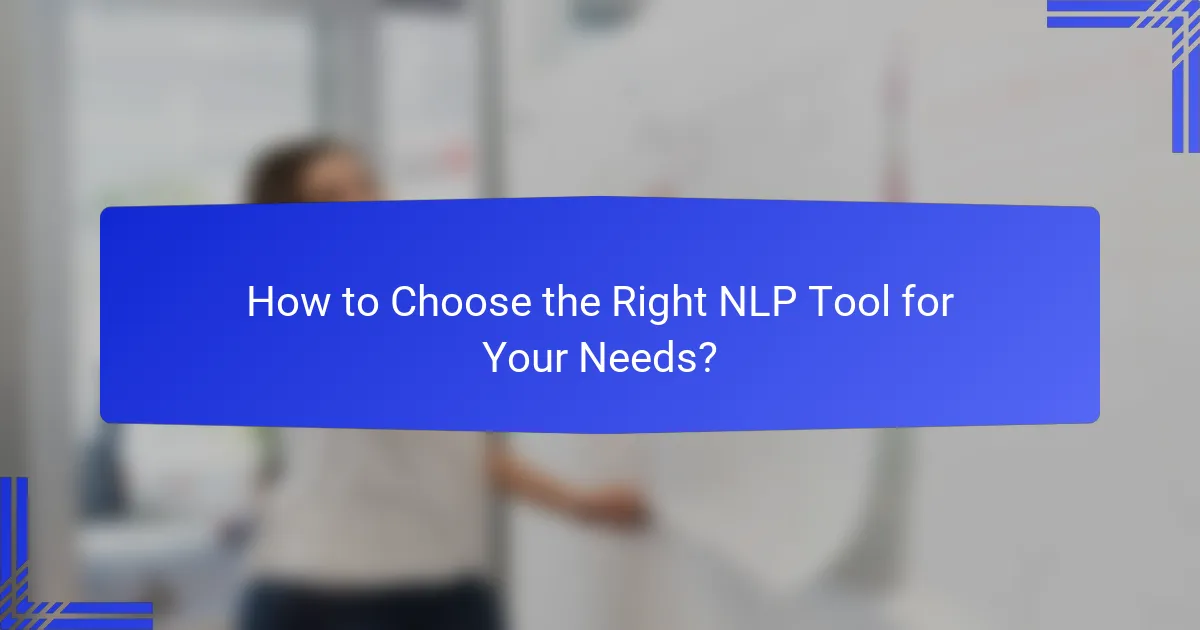
How to Choose the Right NLP Tool for Your Needs?
Choosing the right NLP tool involves understanding your specific requirements, budget, and the capabilities of various options. A well-selected tool can enhance media analysis and provide valuable insights into geopolitical trends.
Assessing Business Requirements
Start by identifying the specific tasks you need the NLP tool to perform, such as sentiment analysis, entity recognition, or topic modeling. Consider the volume of data you will process and the languages involved, as these factors can significantly influence tool selection.
Engage stakeholders to gather insights on their needs and expectations. This collaborative approach ensures the chosen tool aligns with business goals and can adapt to evolving requirements.
Evaluating Pricing Models
Pricing models for NLP tools can vary widely, including subscription-based, pay-per-use, or one-time licensing fees. Assess your budget and consider the total cost of ownership, which may include training, support, and maintenance.
Look for tools that offer tiered pricing based on usage levels. This allows you to start with a basic package and scale up as your needs grow, ensuring you only pay for what you use.
Comparing Tool Capabilities
When comparing NLP tools, focus on their core functionalities, such as accuracy, speed, and ease of integration with existing systems. Check for features like multilingual support and customization options that cater to your specific use cases.
Consider conducting trials or demos to evaluate performance in real-world scenarios. This hands-on approach can reveal strengths and weaknesses that may not be apparent from marketing materials alone.
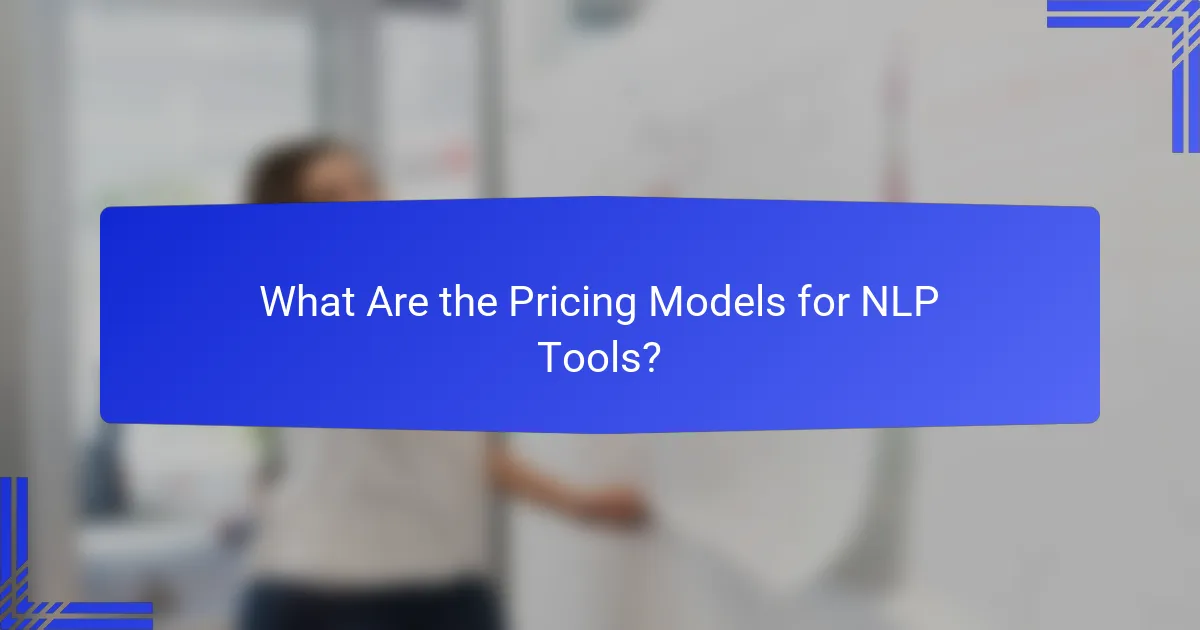
What Are the Pricing Models for NLP Tools?
NLP tools typically employ various pricing models to accommodate different user needs and budgets. The most common models include subscription-based pricing, pay-as-you-go options, and enterprise licensing, each with its own advantages and considerations.
Subscription-Based Pricing
Subscription-based pricing is a popular model where users pay a recurring fee, often monthly or annually, for access to NLP tools. This model provides predictable costs and often includes updates and support as part of the package.
Prices can vary widely, generally ranging from a few dozen to several hundred USD per month, depending on the features and usage limits. Users should evaluate their expected usage to select a plan that aligns with their needs without overspending.
Pay-As-You-Go Models
Pay-as-you-go models charge users based on their actual usage of NLP services, making it a flexible option for those with fluctuating needs. This model is beneficial for projects with unpredictable workloads, as users only pay for what they consume.
Costs in this model can vary significantly depending on the volume of data processed or the number of API calls made. Users should monitor their usage closely to avoid unexpected charges, especially if they anticipate high demand during peak periods.
Enterprise Licensing Options
Enterprise licensing options are tailored for larger organizations that require extensive access to NLP tools across multiple users or departments. These licenses often come with custom pricing based on the scale of usage and specific requirements.
Organizations should consider negotiating terms that include support, training, and integration services, as these can add significant value. It’s essential to assess the total cost of ownership, including any additional fees for exceeding usage limits or for premium features.
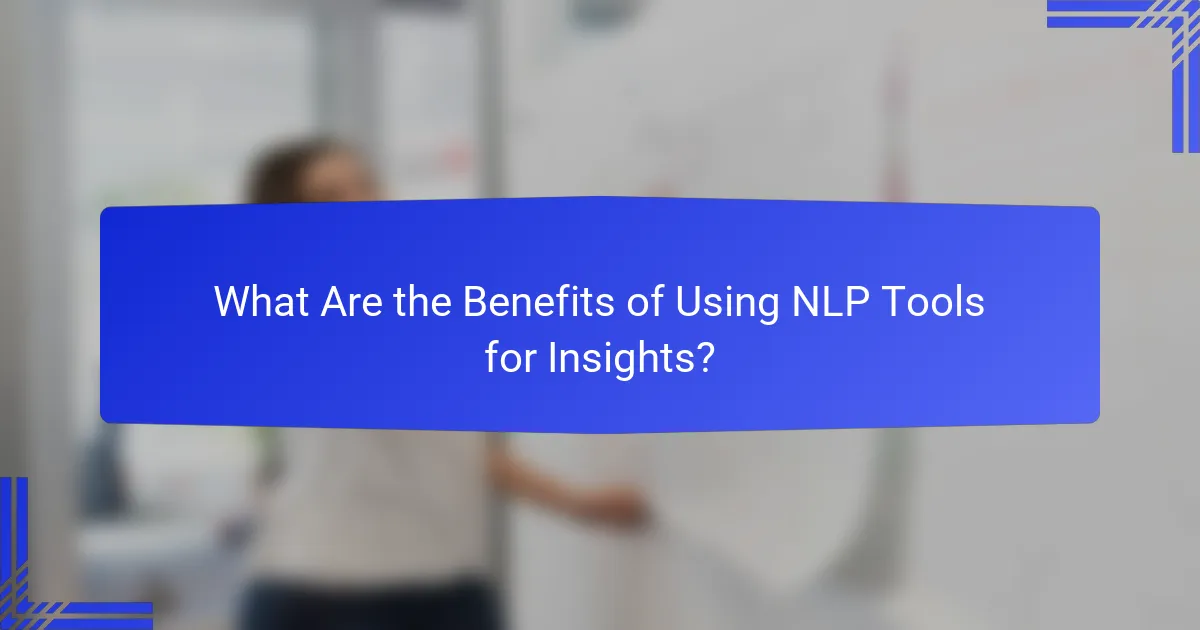
What Are the Benefits of Using NLP Tools for Insights?
NLP tools offer significant advantages for extracting insights from media and analyzing geopolitical trends. They enhance the ability to process vast amounts of unstructured data, enabling organizations to identify patterns, sentiments, and emerging issues quickly and effectively.
Enhanced Data Processing
NLP tools streamline the analysis of large datasets by automating the extraction of relevant information. This capability allows users to sift through millions of articles, social media posts, and reports in a fraction of the time it would take manually. For instance, organizations can analyze news articles to gauge public sentiment on political events within minutes.
By employing techniques like tokenization, named entity recognition, and sentiment analysis, NLP tools can categorize and summarize data efficiently. This not only saves time but also reduces the risk of human error in data interpretation.
Improved Decision-Making
Utilizing NLP tools leads to better-informed decision-making by providing actionable insights derived from complex data. For example, a government agency can monitor social media to understand public opinion on policy changes, allowing them to adjust strategies accordingly. This proactive approach can significantly enhance responsiveness to geopolitical shifts.
Moreover, NLP tools can highlight trends and anomalies that may not be immediately visible, enabling organizations to anticipate potential challenges or opportunities. This foresight is crucial in dynamic environments where timely decisions can have substantial impacts.
Cost and Time Efficiency
Implementing NLP tools can result in considerable cost savings and time efficiency for organizations. By automating labor-intensive processes, businesses can allocate resources more effectively, focusing on strategic initiatives rather than manual data analysis. For example, a media company might use NLP to generate reports on audience engagement, reducing the need for extensive research teams.
Additionally, the speed at which NLP tools operate allows for real-time analysis, which is invaluable in fast-paced sectors like finance and politics. Organizations can respond to emerging trends or crises almost instantaneously, maintaining a competitive edge. For more information, visit this site.
